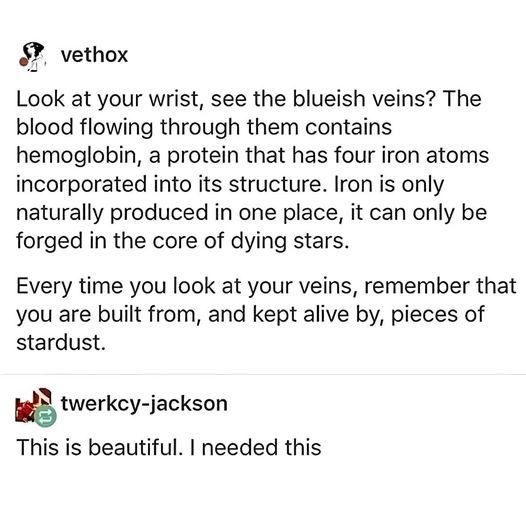this post was submitted on 08 Sep 2024
488 points (95.7% liked)
Science Memes
11148 readers
3095 users here now
Welcome to c/science_memes @ Mander.xyz!
A place for majestic STEMLORD peacocking, as well as memes about the realities of working in a lab.

Rules
- Don't throw mud. Behave like an intellectual and remember the human.
- Keep it rooted (on topic).
- No spam.
- Infographics welcome, get schooled.
This is a science community. We use the Dawkins definition of meme.
Research Committee
Other Mander Communities
Science and Research
Biology and Life Sciences
- !abiogenesis@mander.xyz
- !animal-behavior@mander.xyz
- !anthropology@mander.xyz
- !arachnology@mander.xyz
- !balconygardening@slrpnk.net
- !biodiversity@mander.xyz
- !biology@mander.xyz
- !biophysics@mander.xyz
- !botany@mander.xyz
- !ecology@mander.xyz
- !entomology@mander.xyz
- !fermentation@mander.xyz
- !herpetology@mander.xyz
- !houseplants@mander.xyz
- !medicine@mander.xyz
- !microscopy@mander.xyz
- !mycology@mander.xyz
- !nudibranchs@mander.xyz
- !nutrition@mander.xyz
- !palaeoecology@mander.xyz
- !palaeontology@mander.xyz
- !photosynthesis@mander.xyz
- !plantid@mander.xyz
- !plants@mander.xyz
- !reptiles and amphibians@mander.xyz
Physical Sciences
- !astronomy@mander.xyz
- !chemistry@mander.xyz
- !earthscience@mander.xyz
- !geography@mander.xyz
- !geospatial@mander.xyz
- !nuclear@mander.xyz
- !physics@mander.xyz
- !quantum-computing@mander.xyz
- !spectroscopy@mander.xyz
Humanities and Social Sciences
Practical and Applied Sciences
- !exercise-and sports-science@mander.xyz
- !gardening@mander.xyz
- !self sufficiency@mander.xyz
- !soilscience@slrpnk.net
- !terrariums@mander.xyz
- !timelapse@mander.xyz
Memes
Miscellaneous
founded 2 years ago
MODERATORS
you are viewing a single comment's thread
view the rest of the comments
view the rest of the comments

Incorrect, the hydrogen is mostly from the big bang. Not to mention that neutron star mergers produced a while lot of the heavier stuff.
If that hydrogen was previously incorporated in a star, I think it's fair to call it stardust. That's very likely, since our solar system would have formed from a relatively dense cloud of the remnants of earlier stars, with just a smidge of primordial hydrogen mixed in.
grumpy I guess
Tell me more about primordial hydrogen?!
All of the hydrogen was created at the initial cooling of the big bang. In this case what I mean by primordial, is that it was never part of a larger composite object like a star.
It just means the remnants of the Big Bang that mostly created hydrogen, helium, and lithium. There's nothing particularly special about it other than the possibility that it is as old as creation because there are stable isotopes.
I also like the science behind particles like neutrinos blasting their way through everything in space and matter, even through our own bodies and cells. Every once in a while, one of those tiny particles hits a piece of DNA at just the right spot to cause a chain reaction that leads to a new minor or major mutation in the next generation. It's generally thought that this kind of physics is one of forces that drive evolution of all lifeforms on our planet.
We are made of star stuff ..... and we are and will always be affected by star energy.